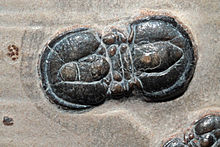Agnostida
| Agnostida Temporal range: Early Cambrian–Late Ordovician |
|
|---|---|
 |
|
| Itagnostus interstrictus | |
| Scientific classification | |
| Kingdom: | Animalia |
| Phylum: | Arthropoda |
| Class: | †Trilobita |
| Order: |
†Agnostida Salter, 1864 |
| Families | |
|
Suborder Agnostina
Suborder Eodiscina |
|
| Synonyms | |
|
Isopygia Gürich, 1907 |
|
Suborder Agnostina
Suborder Eodiscina
Isopygia Gürich, 1907
Miomera Jækel, 1909
Agnostida is an order of arthropod which first developed near the end of the Early Cambrian period and thrived during the Middle Cambrian. They are present in the Lower Cambrian fossil record along with trilobites from the Redlichiida, Corynexochida, and Ptychopariida orders. The last agnostids went extinct in the Late Ordovician.
The Agnostida are divided into two suborders — Agnostina and Eodiscina — that are then subdivided into a number of families. As a group, agnostids are isopygous, meaning that their pygidium is similar in size and shape to their cephalon. Most agnostid species were eyeless.
The systematic position of the order Agnostida within the class Trilobita remains uncertain, and there has been continuing debate whether they are trilobites or a stem group. The challenge to the status has focused on the Agnostina partly because juveniles of one genus have been found with legs greatly different from those of adult trilobites, suggesting they are not members of the lamellipedian clade, of which trilobites are a part. Instead, the limbs of agnostids closely resemble those of stem group crustaceans, although they lack the proximal endite, which defines that group. They are likely the sister taxon to the crustacean stem lineage, and, as such, part of the clade Crustaceomorpha. Other researchers have suggested, based on a cladistic analyses of dorsal exoskeletal features, that Eodiscina and Agnostida are closely united, and that the Eodiscina descended from the trilobite order Ptychopariida.
...
Wikipedia
